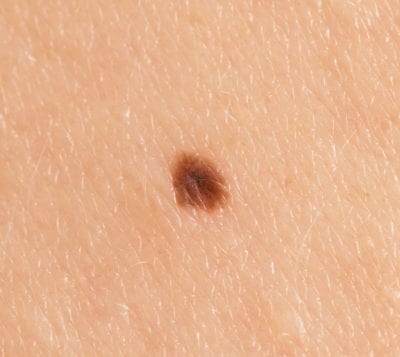Mole Removal
What are moles?
 Moles are growths on the skin that are usually brown or black. Moles can appear anywhere on the skin, alone or in groups. Most moles appear in early childhood and during the first 25 years of a person’s life. It is normal to have between 10-40 moles by adulthood. As the years pass, moles usually change slowly, becoming raised and/or changing color. Sometimes, hairs develop in the mole. Some moles may not change at all, while others may slowly disappear over time.
Moles are growths on the skin that are usually brown or black. Moles can appear anywhere on the skin, alone or in groups. Most moles appear in early childhood and during the first 25 years of a person’s life. It is normal to have between 10-40 moles by adulthood. As the years pass, moles usually change slowly, becoming raised and/or changing color. Sometimes, hairs develop in the mole. Some moles may not change at all, while others may slowly disappear over time.
There are several types of moles. Congenital nevi are moles that are present at birth. Congenital nevi occur in about one in 100 people. These moles are slightly more likely to develop into melanoma than are moles that appear after birth. A mole or freckle should be checked if it has a diameter of more than a pencil eraser or any characteristics of the ABCDEs of melanoma (see below).
Dysplastic nevi are moles that are generally larger than average (larger than a pencil eraser) and irregular in shape. They tend to have uneven color with dark brown centers and lighter, uneven edges. These nevi are somewhat more likely to become melanoma. In fact, people who have 10 or more dysplastic nevi have a 12 times higher chance of developing melanoma, a serious form of skin cancer. Any changes in a mole should be checked by a dermatologist to evaluate for skin cancer.
It is important to examine your moles often so that you know the pattern and placement of moles so that you can identify any potential problems early. When monitoring your moles, it is useful to remember the “ABCDE” method of self-examination:
- “A” is for Asymmetrical. Look for moles with an asymmetrical shape, such as two very different looking halves. Unlike common moles, atypical moles are often asymmetrical: A line drawn through the middle would not create matching halves.
- “B” is for Border. Watch for moles with irregular, ragged or blurred borders. While common moles usually have regular, sharp, well-defined borders, the borders of atypical moles tend to be irregular and/or hazy — the mole gradually fades into the surrounding skin. These are characteristics of melanoma.
- “C” is for Color. Watch for moles that have different colors throughout, or contain shades of brown, black, blue, or white, or red. Common moles are most often uniformly tan, brown or flesh-colored, but atypical moles have varied, irregular color with subtle, haphazard areas of tan, brown, dark brown, red, blue or black.
- “D” is for Diameter. Look for moles that are larger than the eraser of a typical #2 pencil. Atypical moles are generally larger than 6 mm (¼ inch), but may be smaller.
- “E” is for Evolution. Monitor for changes over time. For example, watch for a mole that grows or changes shape or color. Enlargement of or any other notable change in a previously stable mole, or the appearance of a new mole after age 40, should raise suspicion.
treating moles
If a ClearlyDerm provider believes a mole needs to be evaluated further, the mole removal dermatologist will do a biopsy by shaving or cutting out the entire spot so that it can be evaluated under the microscope. This is a simple procedure.
If the mole is found to be cancerous, the mole removal dermatologist will cut out the entire mole or scar from the biopsy site by cutting out the entire area and a rim of normal skin around it, and stitching the wound closed. We strongly recommend that you, always wear sunscreen when possible and cover up exposed areas of your skin.
If you have noticed an unusual spot on your skin, let the professionals at our mole removal clinic in Boca Raton, Boynton Beach, or Ft. Lauderdale complete an evaluation and consultation. No matter what type of mole you want to get rid of, we can take care of it at our mole removal clinic. We look forward to hearing from you!





